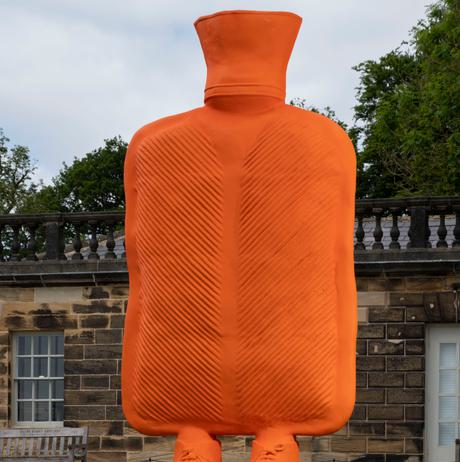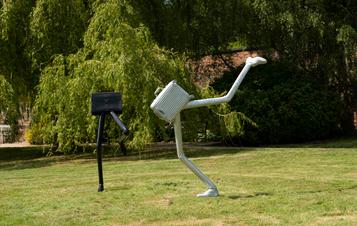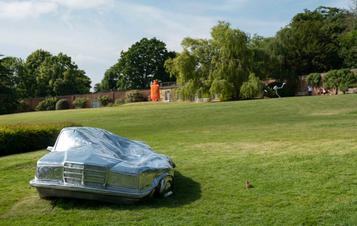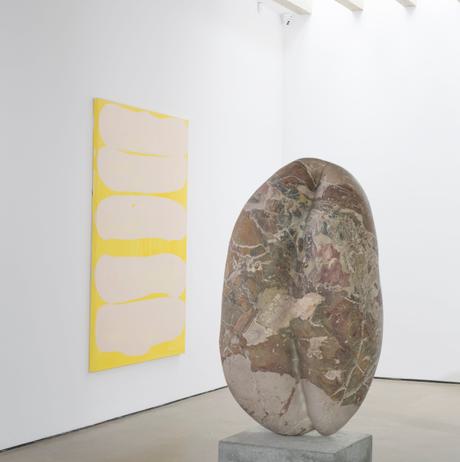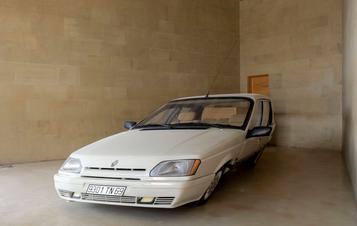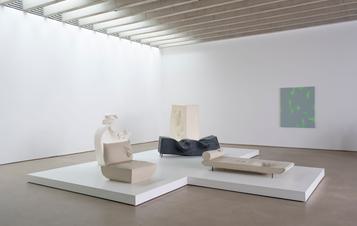
About Erwin Wurm: Trap of the Truth
"Infused with quirky humour- it's art that puts a smile on your face"
- Yvette Huddleston, The Yorkshire Post
Trap of the Truth featured more than 100 works, including 55 sculptures indoors, 19 sculptures in the landscape, paintings, photographs, videos and drawings created over 30 years of the artist’s career. Several works were shown for the first time.
Erwin Wurm (b.1954) is one of Austria’s most prominent artists, highly regarded for his 2017 Austrian Pavilion at the Venice Biennale. Over three decades he has challenged the rules of sculpture, the limitations of the human body, and its relationship to the spaces we inhabit. His work disrupts perceptions of the familiar and sensible and in a process that abounds with humour and experimentation, he frequently reimagines commonplace objects by giving them human characteristics. Wurm ponders what sculpture is and what it can be, stretching its boundaries, and calling into question the value and importance we place on everyday objects. He is both playful and political, using ludicrous scenarios to create work that addresses how we conform to society’s demands and how sculpture can upend cultural beliefs.

“At some point I came to realise that everything surrounding me can be material for an artistic work, absolutely everything. To begin with, because I had no money and worked relatively quickly, I used scraps of wood and cans. Then I used old clothing, which did not cost anything, before ultimately realising that I could actually use anything around me. That was the decisive step, as then anything was possible.”
- Erwin Wurm
Big Kastenmann (2012), which translates as ‘big box man,’ stands at five metres tall, with a large box for a torso wearing a formal pink and grey suit jacket. This was Wurm’s first large-scale public art project, displayed outside The Standard Hotel in New York City in 2012. His 3.2-metre-tall bronze Balzac (2023) was also shown for the first time – the majestic human form created by elaborate layers of robes reminiscent of ancient classical statuary and referencing Rodin’s sculpture of the same name. The work was generously gifted to YSP by Wurm, and will remain on display on the Formal Terrace following the closure of the exhibition.
Drawing on his nation’s historic and cultural identity, Wurm interprets popular Austrian food items, the most iconic of which is the gherkin, or pickled cucumber, with which he has a longstanding fascination. It was presented here with the four-metre-high bronze Der Gurk (2016), while three of Wurm’s Giants from the Abstract Sculptures series (2013-23), are anthropomorphised bronze sausages that reference the wiener hot dog, which takes its name from Austria’s capital, Vienna. Both foodstuffs lend themselves to being monumentalised as sculpture and propose contemporary readings of totems, idols, obelisks and other ancient sculptural forms.
Introducing us to Wurm’s philosophical contemplation, the exhibition title Trap of the Truth refers to the thinking of influential 17th-century French philosopher René Descartes, who set out to interrogate the subjectivity of truth. This questioning of reality is immortalised in the phrase “I think, therefore I am”.
Outdoors, 19 sculptures occupied YSP’s heritage landscape, including new and never-before-seen works. Three sculptures from Wurm’s Bags series explore consumer culture and objects of status. They included the five-metre-tall, pastel blue Big Step (2023), which takes the form of a couture bag with long elegant legs, wearing fashionable boots.Dance (2021) and Trip (2021) – a briefcase and suitcase respectively – completed the series, with their long, dynamic legs giving a sense of human life within the landscape.
"Think the Wurm show is brilliant! Art can be fun as well as serious."
- YSP Visitor
In the Underground Gallery, a selection of over 50 sculptures unravelled the complexities of Wurm’s practice, alongside 60 two-dimensional works illustrating the artist’s prolific drawing practice in pen, crayon, and watercolour.
The earliest gallery work is Renault 25 from 1991. It is a full-size adapted Renault 25 car that has been reformed on a tilt, as though distorted by cornering at speed. This reference to animation, comic-book illustration and popular culture sets the scene for Wurm’s inclination to the absurd and desire to undermine conformity.
In Gallery One, works from Wurm’s Attacks and Concrete Sculptures series referenced philosophers, psychologists and thinkers from the mid-19th to the mid-20th century, including Friedrich Nietzsche, Karl Marx and Ludwig Wittgenstein. Such intellectuals are frequently memorialised by their houses or cabins and Wurm continues this notion of lionising spaces for solitude by representing his own workspace with the aluminium Eiswerk – My Studio (The Kitchen and Bedroom Hanging Down) (2005), an irrational and self-deprecating representation of his home and studio in Limberg, Austria.

"I adore how Erwin Wurm teases the mind. Definitely seeing things differently."
- YSP Visitor
The ConcreteSculptures from 2022 take what appear to be fragments of demolished structures, including iron wire, wood and stone, and merges them with cast-concrete forms of houses and cars. The 2022 Attacks are bronze and aluminium buildings and cars that have been squashed by oversized sausages and bananas in a humorous, yet discomforting manner. A 5.6-metre-long Mercedes truck shows the vast variation in scale with which Wurm works, and the bright red bending Truck II (2011) appears to have reversed up the gallery wall where it rests, precariously.
Wurm came to prominence in the 1990s with his One Minute Sculptures – an ongoing series of works where the artist gives written or drawn instructions for participants to pose with ordinary objects such as buckets, fruit or chairs for a limited time. He documents these fleeting interactions, where the viewer becomes the artwork, with photographs and video, a selection of which will be displayed alongside several of the objects. Extending the idea of viewer as artist, art object and participant, Ship of Fools (2017) is an adapted caravan with which visitors can interact by putting their heads, hands, bottoms, or feet through apertures, encouraging disruption and disorder in the normally hallowed museum setting.
Carved from marble, the Icons sculptures immortalise bread, sausages and a coffee bean – literally giving them the status of classical statuary by putting them on a pedestal. Alongside are seven ceramic sculptures from the Dissolution series, which Wurm started to make in 2018 in a bid to return to the physical and direct act of making. Including works titled Double Ear Head, Noser and Mud Kiss, they incorporate body parts associated with human senses continuing Wurm’s consideration of the body and how we experience the world around us.
Completing the exhibition are six Flat Sculptures – oil on canvas works that the artist started painting 2020. Primarily working with sculpture, Wurm translates notions of form and volume to the brightly painted canvases, which have stretched and distorted letters spelling out their respective titles into almost unrecognisable shapes.
This exhibition was accompanied by a lively programme of engagement activity centred around play, exploration of materials and experimentation of making processes. An illustrated guide and catalogue featuring in-situ photography accompanied the exhibition.
The exhibition was supported by Thaddaeus Ropac and Lehmann Maupin.
"Brilliant exhibition. Loved the interactive element and the German cultural elements (as a former long time resident of Germany)."
- YSP Visitor
Free activities for families
Explore creative ideas to help you discover the Erwin Wurm exhibition.
"The kids loved mimicking the sculptures and testing out the interactive ones too ... the caravan was such fun!!"
- YSP Visitor
More from Erwin Wurm
In 2003, American rock band Red Hot Chili Peppers payed homage to Erwin Wurm's One Minute Sculptures in the video for their eighth number one single Can't Stop.

You may also like
- News

Generous sculpture gift to YSP by Austrian artist Erwin Wurm
8 April 2024 - News

Yorkshire Sculpture Park announces 2023 programme
16 November 2022 - Art Outdoors

Masayuki Koorida: Form Twist; Growth; Kids; Flower
Internationally known for his abstract stone sculptures, Masayuki Koorida commonly works with granite or black or white marble. The artist’s works are directly carved and highly polished to a smooth finish. - Art Outdoors
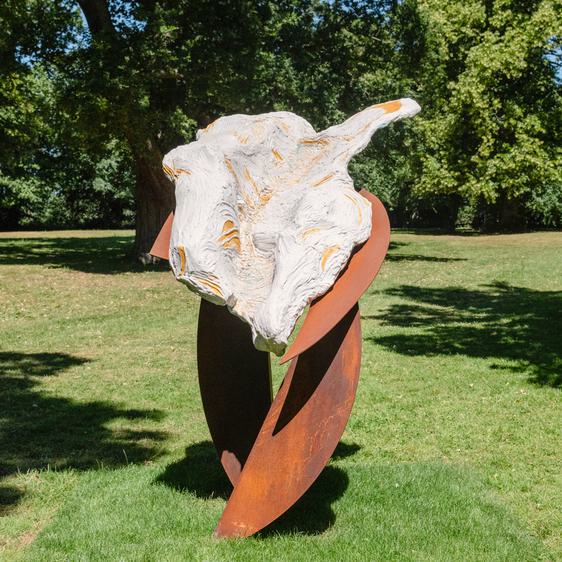
Ro Robertson: Stone (Butch)
Robertson’s Stone (Butch) (2021) is part of a body of works exploring the terrain of the queer body in the landscape and was created by plaster casting directly in crevices in natural rock formations at Godrevy Point (St Ives Bay, Cornwall).
